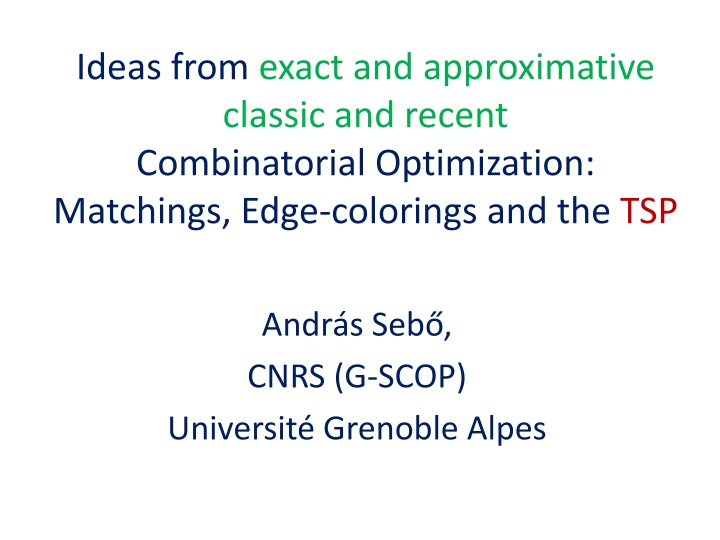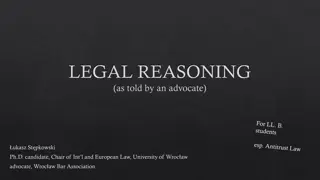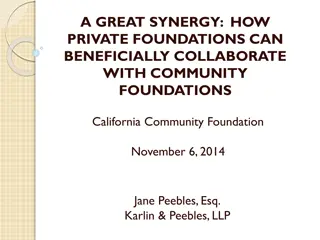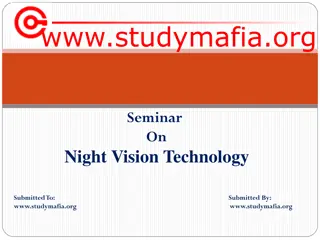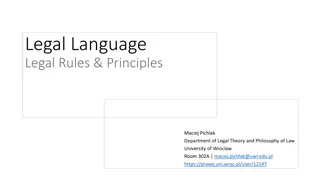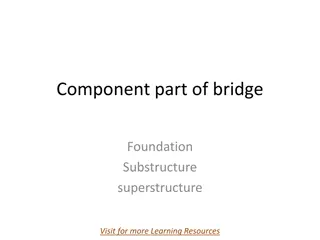Legal Foundations and Future Vision for Biotop Network in Styria
Ethical approach to biodiversity conservation, importance of Biotop network, legal framework, implementation in Styrian Nature Conservation Law, and Austria's Biodiversity Strategy.
Download Presentation

Please find below an Image/Link to download the presentation.
The content on the website is provided AS IS for your information and personal use only. It may not be sold, licensed, or shared on other websites without obtaining consent from the author.If you encounter any issues during the download, it is possible that the publisher has removed the file from their server.
You are allowed to download the files provided on this website for personal or commercial use, subject to the condition that they are used lawfully. All files are the property of their respective owners.
The content on the website is provided AS IS for your information and personal use only. It may not be sold, licensed, or shared on other websites without obtaining consent from the author.
E N D
Presentation Transcript
Ideas from exact and approximative classic and recent Combinatorial Optimization: Matchings, Edge-colorings and the TSP Andr s Seb , CNRS (G-SCOP) Universit Grenoble Alpes
Part A : MATCHING S te 11-15 juin 1. Basics 2. Edge-colorings Tashkinov (2000) for me: dec. 2017 3. Algorithms Method of variables, class RP Exact Matchings (Yuster, 2012 ), for me: June 2018 Edmonds algorithm 4. Undirected shortest paths Conservativeness, T-joins, Algorithms 5. Polyhedra, weights, Linear Programming Approximation: additive error of 1 for edge- coloring and exact matching Randomized algorithms, LP lower bound Exercises : series 1-5
Part B : TSP 1. Classical s=t, General metric 2. Two-edge-connected spanning subgraph ear theorems `graph TSP , s=t (S., Vygen) 2014 Submodular functions, matroids matroid intersection and approx. of submod max 3. General s,t path TSP Zenklusen s 3/2 approx algorithm (April 2018) Exercices series 6 Approximation : constant ratio
Matching G=(V,E) graph. matching : a set M E of vertex-disjoint edges. perfect matching : In addition M partitions V. INPUT : G=(V,E) graph. TASK : Find a matching of maximum size Do the red edges form a maximum matching ?
Augmenting Paths augmenting path with respect to matching M : path alternating between M and E \ M with the 2 endpoints uncovered by M. Proposition (Berge) : G graph, M matching in G. M is a maximum matching in G iff there is no augmenting path Matching polytope: = conv ( M : M matching ) M (e) = 1 ?? ? ? 0 ?? ? ? Perfect matching polytope: = conv ( M : M perfect matching )
Interpretation with random sampling x = ? M ? M, ( M 0, M M M= 1), M a set of p.m. M can be viewed as a p.m. valued random variable Pr (M= M) = ? Then for e E: Pr (e M) = x(e) E[M] = x Particular distributions (max entropy, or comb. restrictions) Our use is notational, mainly:E[F + J] = E[F] + E[J]
Matching and vertex cover matching : M set of vertex-disjoint edges Max |M| : vertex cover : T set of vertices so that G-T has no edges Min |T| :
Min max Theorem (K nig) : If G=(V,E) is bipartite, then (G)= (G) Exercise 1.2 Proof: is the proven easy part ; is to be proved: If for some v V : (G v) = (G) 1 , by induction : (G) = (G v) +1 = (G v) + 1 (G) . If uv E then either u or v satisfy this condition ! Exercise 1.1 Q.E.D.
2. Edge-coloring Def : G=(V,E). edge-coloring : each color is a matching Edge-chromatic number = chromatic index = :=min n. of colors
Bipartite edge-coloring Theorem (K nig) : If G=(V,E) is bipartite, then (G)= (G) Exercise 2.2 Proof: Now is now the easy part ; is to be proved: If uv E is not yet colored then u , v both miss some color ! If it is the same color or can be recolored so : DONE If not, they are joined by an even path: Q.E.D. v Exercise 2.1 u
Tashkinov tree 1 v v Exercise 2.3 BFS tree F from {u,v,uv} using only edges whose color has already been missed before u u a. There is a common missing color in u and N(u) on F uv can be colored v v v u u u
Tashkinov tree 2 b. There are two neighbors of u in F missing the same color uv can be colored swap a red-green component v v u u Reduced to Case a.
Vizings theorem Theorem: If G=(V,E) is simple, then (G) (G) +1 Exercise 2.4 Proof: Color as much as you can with (G) +1 colors. Then : every vertex has always a missing color ! v Exercise 2.3 u either a. or b. : a. There is a common missing color in u and N(u) on F b. There are two neighbors of u in F missing the same color either uv can be colored
Tashkinovs theorem Generalizing the above proof : Theorem: If such a BFS tree has two vertices missing the same color, then all colored edges + edge uv can be colored . Corollaries: Better and better edge-coloring
3. Algorithms Method of variables, class RP Exact Matchings Edmonds algorithm
The method of variables (Tutte, Lov sz, Geelen, ) G = (A, B, E) bipartite, |A|=|B|. M := (xij if ij E, else 0 )n n : Proposition : det(M) is a nonzero polynomial perfect matching Proof : All terms of M are different, so there is no cancellation. n! Terms, but determinants can be computed in polynomial time : randomized algorithm: substitute values and then compute ! Questions : If then the det is nonzero can we conclude ? If it is zero ? What to do for nonbipartite graphs ?
The method of variables The probability of error, precisely Lemma: (Schwartz, Zippel) Let q be a nonzero polynomial of n variables x1, , xn, and let it be of degree d ; S IN is finite, s:=|S|. Moreover, let X1, , Xnbe random variables taken independently and uniformly from S. Then Pr (q(X1, , Xn)=0) d/s . Proof: For n=1 obvious. Let p Q[x1, , xn-1] the coefficient of the highest power of xn, and let be the degree of p. Pr (q(X1, , Xn)=0) Pr (p(X1, , Xn-1)=0) + Pr (q(X1, , Xn)=0 |p(X1, , Xn-1) 0) /s + /s d/s
The method of variables A Randomized Algorithm Oracle Algorithm : An oracle tells the substitution values of a polynomial in pol(deg) time. 1. Let S = {1, ,2n}. 2. Make independent uniform choices in S for each variable. 3. Compute the polynomial (oracle call) for the chosen values. If 0 : the polynomial is nonzero ( perfect matching) If =0 ? We decide: no perfect matching: Pr (error) Why not bigger S ? Better to choose |S| = const x deg and repeat ! Proposition : After O( log 1/ ) repetitions Pr (error )
The complexity class P RP NP Imagine : x= a graph, y the certificate (eg a substitution with 0 polynomial value ) The same def as NP but there are many certificates : constant proportion
Randomized algorithms for matching generalizations RP thought of P G = (A, B, E) bipartite, n= |A|=|B|. M := (xij if ij E, else 0 )n n G = (V, E), n= |V| skew symm M := (xij= -xji if ij E, else 0 )n n `Tutte matrix : square of the `Pfaffian . Good for testing ! Path matchings (Cunningham, Geelen) Exact matching: Given R E, k IN, a max matching M, |M R|=k. Exact matching multiplying xij for ij R by y in the Tutte matrix, the coeff of yk is not the 0 pol: substitution this pol can be evaluated with n+1 x n+1 lin equ; RP (Lov sz 1979) and not known to be in P !
Approximation for exact matchings Theorem : (Yuster 2012) G=(V,E) graph, R E , k IN, then Exactly one of the following possibilities holds : (i) Each maximum matching of G meets R in < k edges. (ii) Each maximum matching of G meets R in > k edges. (iii) There exists a matching of size at least (G) 1 that meets R in = k edges Remark: (i), (ii) certified, checked in polytime (weighted match.) Proof: If neither (i) nor (ii) holds, Then M1: R-min max matching M2: R-max max matching How to have 3 red ? Additive error of 1
Tutte-Berge theorem Theorem : Let G=(V,E) be a graph. Then the minimum, over all matchings M of the number of uncovered vertices of V = max { q(X) - |X| : X V } Def : q(X) is the n. of comps of G-X having an odd number of vertices Proof: : easy. : Exercise 1.4 We can adapt the proof of K nig s theorem: - If (G v) = (G) 1 , induction is easy. - If (G u) = (G - v) = (G), apply Exercises 1.1, 1.3, 1.5 extended. Hint : Observe that the new vertex is unconvered by a (actually two) maximum matching of the contracted graph. Can it be in X ? See Exercise 1.5. Q.E.D.
Edmonds algorithm 1. Grow an (inclusionwise max) alternating forest F rooted in uncovered vertices 2. If two even vertices are adjacent a.) between 2 different components : augment b.) in the same component : Adapt Exercise 1.3 to this case. Heureka you shrink ! (Edmonds) In both cases GOTO 1 (possibly using the actual forest). root even odd 3. If there is no edge between the even vertices STOP X:= odd vertices Theorem : X is a Tutte-set and F is a maximum matching
Summary of algorithms for matchings Unweighted : - Algorithms for bipartite graphs: paths in digraphs; - Method of variables - Edmonds algorithm; - Structural algorithms (for matchings by Lov sz, S.:T-joins, b-match) Weighted : Mainly two possibilities - Primal-Dual framework with max cardinality subroutine - Ellipsoid method
